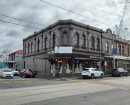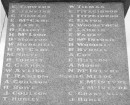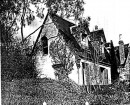AH YOUNG'S GARDENS
SLATY CREEK ROAD CABBAGE TREE, HEPBURN SHIRE
-
Add to tour
You must log in to do that.
-
Share
-
Shortlist place
You must log in to do that.
- Download report
Statement of Significance
This record has minimal details. Please look to the right-hand-side bar for any further details about this record.
-
-
AH YOUNG'S GARDENS - History
Ah Young created a series of small terrace gardens on the south-western slopes of Humbug Hill in the 1880s and 1890s. He was one of at least 30 Chinese men working a garden in the Slaty Creek and Mopoke area at this time. Most had held a Miner's Right for many years, and occupied a hut and a small patch of land, from 8 to 1 acre in size (La Gerche 1885). Forester John La Gerche kept a close eye on the Chinese gardeners and fossickers scattered through the Creswick forests, and at times he intervened on their behalf to ensure they received fair treatment (Taylor 1998: 102).
Ah Young built terraces that extended shelves of natural level ground, and in one case he constructed a low retaining wall on the downslope slide to retain water and prevent run-off. The soil in the terraces has mostly reverted to clay, but originally it had been improved with compost and manure. Ah Young also built at least two small dams for watering the gardens. The higher of these was a simple clay wall held together with tree branches, about 3-4 metres across, with water brought in from a race to the north. An apple tree that had grown for more than a century beside this dam was killed in the drought several years ago (D. Henderson pers. comm. 2 March 2012).
Updated 2/06/2021
Ah Young developed the garden in the 1880s and ran it with his European wife until the late 1920s, when she died and he returned to China. David Henderson’s mother (born 1913) had childhood memories (recorded by David Henderson the 1950s, personal Communications 2010 and 2020) of buying vegetables from Ah Young’s house where there was also a small patch of garden north of Slaty Ck Rd, hidden from the road opposite the Brewery (David Henderson Map 2012). The garden (and the market) probably changed a lot over the years as land was sluiced and bed areas were fitted in between mining activity. Some writers estimate that 20-30 people lived at and worked in the gardens at various times. The area has remained relatively undisturbed, until recent incursions by mountain bikes and amateur fossickers with metal detectors.
Even after the main gold rush ended in the 1860s, the Cabbage Tree Flat south of Humbug Hill was an extremely active area, with hotels, dredges and their offices, a three story malthouse and brewery, a bank and several other businesses. [Creswick Advertiser 28/6/1860, quoted by Henderson 2010]. There was also a large vineyard and cherry orchard, a brewery and a thriving school on Cabbage Tree Hill (DC Henderson Map 2012). Mining activity changed constantly, as new and methods and tools (e.g. pumps) were introduced and as mining and water infrastructure companies came and went. It is in this context that Ah Young and his wife developed and ran this large garden for 30 years in a changing but often vibrant market. The size/area of land used probably varied with the local population and markets, and also with the rains and seasons and
water supply available. Ah Young is said to have held a mining license, and used water delivered by (Bragg’s and Russell’s and probably other) waters races, mainly for sluicing activity by other miners (Taylor 1998).
AH YOUNG'S GARDENS - Interpretation of Site
Small scale Chinese garden for supplying miners in the region around the turn of the century. As noted above, the garden beds were hewn and levelled out of and spread across a very rough and dry hillside, that was constantly being sluiced for mining by over the years. The garden beds and watering systems had to be fitted and levelled between major sluicing gullies, and gardeners using a variety of water sources: ponds, drainage channels, races and small dams. The garden comprises a number of bed areas, mainly on the northeast of the site away from roads (See Fig 1). Ah Young and his wife sold produce from a stall at their house north of and set back from Slaty Ck Road next to a smaller garden area below a water race. A large Brewery (Quinns) operated on the south side of Slaty Ck Road. Braggs Water Race and Dam is listed on the Heritage Inventory (HI) (Number H7623-0333 ) in relation to Ah Youngs Garden as highly significant in interpretation of Creswick cultural and mining history. The race was constructed in the early 1850s to service the Humbug Hill Sluicing Company’s claims at Humbug Hill. Water from the race was sold to miners along the race route and later the race was taken over by the Council and was partly leased to Chinese miners. The race (and a small dam) allowed sluicing of the southern parts of Humbug Hill – in the area of Ah Youngs Gardens. The race and dam appear to fall into disuse by the early 20th century. Races built later by other companies (Russells Race) were higher in the landscape and so allowed mining of the higher parts of Humbug Hill.
AH YOUNG'S GARDENS - Archaeological Significance
This site has a high level of archaeological significance. The features include terraces and dam walls and Chinese artefacts. The site is a rare intact local example of a small scale Chinese garden.
AH YOUNG'S GARDENS - Historical Significance
The site has a high level of historical significance at a local level. Due to the excellent
preservation of a large part of the Creswick goldfield, the intertwined narratives of mining,
water supply, environmental consequences and rapidly evolving legislation can be read in
the landscape. At a state level the site contributes to broader narratives of water supply
and mining (Victorian Historical Theme 4.5 & 4.6) and informs the development of both
mining and water management laws for the State of Victoria.
The site contributes to the understanding of the Chinese communitiy at Creswick.
The garden system is a rare local example on the Creswick alluvial goldfield that together
with water races and dams make up an important and well preserved cultural landscape
of water management.
Combined with Creswick's strong forestry education facilities and proximity to Melbourne
and Ballarat, an increased awareness in this well preserved mining complex could provide
Creswick with excellent educational and tourism opportunities illustrating mining
techniques and how mining shaped Victoria's water laws
Heritage Inventory Description
AH YOUNG'S GARDENS - Heritage Inventory Description
Chinese garden complex comprising terraces and earthern walls for retaining water. The details of ‘ridges’ of garden beds here are not as visible as at some other garden sites. Here they are on levelled areas (‘terraces’) now covered with indigenous vegetation, hewn out of very rugged and highly sluiced hillslope. These level ‘terraces’ have relatively friable soil compared to the hillside, and are spaced among remnant water channels, diversion banks, drains and 4 m height erosion pedestals. Three small watering ponds are easily visible.
-
-
-
-
-
HUMBUG HILL HYDRAULIC GOLD SLUICING SITE
 Victorian Heritage Register H1228
Victorian Heritage Register H1228 -
LINCOLN GULLY
 Victorian Heritage Inventory
Victorian Heritage Inventory -
HUMBUG HILL WORKINGS
 Victorian Heritage Inventory
Victorian Heritage Inventory
-
-







